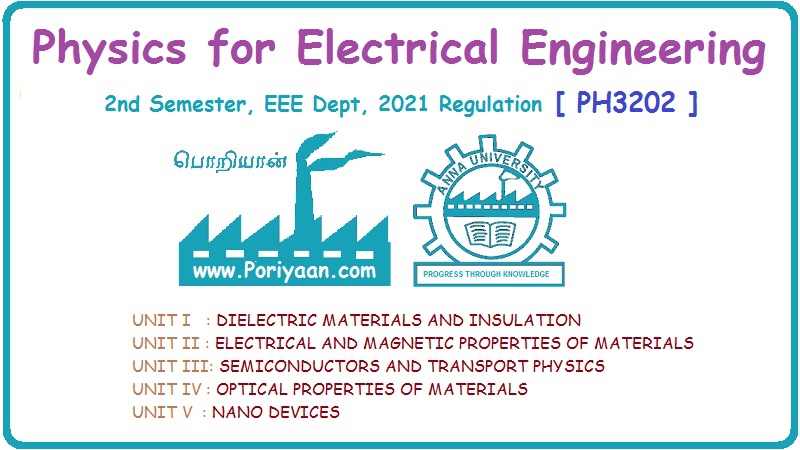Physics for Electrical Engineering: Unit II: a. Electrical Properties of Materials
Part A - 2 Marks Questions and Answer
Electrical Properties of Materials | Physics for Electrical Engineering
Physics for Electrical Engineering: Unit II: Electrical and Magnetic Properties of Materials : Part - A '2' Marks Q and A Anna university Q and A
Part - A '2' Marks Q
& A
ANNA UNIVERSITY
Q&A
1. Give any two postulates of
classical free electron theory. (A.U. Dec 2016)
•
According to this theory, a metal consists of a very large number of free
electrons. These free electrons move freely throughout the volume of the metal.
They are fully responsible for the electrical conduction in the metal.
• Drude assumed that the free electrons in a metal form an electron gas. These free electrons move randomly in all possible directions just like the gas molecules move in a container.
2. Define mean free path.
(A.U. Dec 2011, June 2012)
The
average distance travelled by a free electron between any two successive
collisions in the presence of an applied field is known as mean free path.
It
is the product of drift velocity of electrons (vd) and collision
time (τc).
λ
= vd × τ c
3. Define relaxation time of an
electron. (A.U. May 2011, Dec 2012)
The
average time taken by a free electron to reach its equilibrium state from its
disturbed state due to application of an external electrical field is called relaxation time.
4. Define drift velocity of
electron. How is it different from the thermal velocity of an electron? (A.U.
May 2014, Dec 2015)
The
average velocity acquired by a free electron in a particular direction after a
steady state is reached on the application of an electrical field is called
drift velocity. It is denoted as vd and its value is very small (50
cm/s).
The
thermal velocity is random in nature and its value is very high (105
m/s),
5. Define mobility of electrons. (A.U.
May 2016)
The
magnitude of the drift velocity acquired by the electrons per unit electric
field is defined as the mobility of electrons (µ)
ti.e.,
μ = vd / E
where
vd→ Drift velocity of electrons
E
→ Electrical field.
6. Define electrical conductivity.
What is its unit. (A.U.
April 2011, Dec 2012)
The
amount of electrical charges (q) conducted per unit time (t) across unit area
(A) of the conductor for unit applied electrical field (E) is defined as
electrical conductivity.
σ
= q / t A E
Its
unit is ohm-1 m-1 or mho m-1
7. What are the merits of classical
free electron theory? (A.U. May 2012)
•
It is used to verify Ohm's law.
•
It is used to explain electrical and thermal conductivities of metals.
•
It is used to derive Wiedemann - Franz law.
•
It is used to explain the optical properties of metal.
8. What are the drawbacks of
classical free electron theory? (A.U. May 2011, June
2013, Dec 2015)
•
Classical theory states that all free electrons will absorb the supplied
energy; on the contrary, quantum theory states that only a few electrons will
absorb the supplied energy.
•
Electrical conductivity of semiconductors and insulators (non-metals) cannot be
explained.
•
The phenomena such as photo-electric effect, Compton effect and black body
radiation cannot be explained on the basis of this theory because these
phenomena are based on quantum theory.
9. Define Fermi distribution
function. (A.U. May 2013)
The probability F (E) of an electron occupancy
for a given energy level at temperature T is known as Fermi distribution
function. It is given by
F(E)
= 1/ 1+e (E-EF)/kT
EF→
Fermi level
k→
Boltzmann's constant
T→
Absolute temperature
E→
Energy of the level whose occupancy is being considered.
10. Write down the expression for
the Fermi distribution law and explain for the electrons in a metal.
(A.U. May 2016)
Fermi
distribution function is given by of beau ei 11
F
(E)=1 /1+ e (E-EF)/kT
where
EF is called Fermi energy
if
E<EF, all levels are filled with electrons
i.e.,
F(E) = 1
if
E>EF, all levels are empty
i.e.,
F (E) = 0
if
T>0K at EF,
F
(E) =1/2
11. Define Fermi level and Fermi
energy with its importance. (A.U. Dec. 2012, May 2013, Dec
2014, June 2013, Dec 2016)
Fermi level:
It is the energy level at finite temperature above 0 K in which the probability
of the electron occupation is 1/2 and it is also the level of maximum energy of
the filled states at 0 K.
Fermi energy:
It is the energy of the state at which the probability of the electron
occupation is 1/2 at any temperature above OK. It is also the maximum energy of
filled states at 0 K.
Importance: Fermi
level and Fermi energy determine the probability of an electron occupation for
a given energy level at a given temperature.
12. Define density of states. What
is its use? (A.U. June 2013, Dec 2014, June 2016)
It
is defined as the number of available electron states per unit volume in an
energy interval E and E+ dE. It is denoted by Z (E).
It
is used to determine Fermi energy at any temperature.
13. Calculate the drift velocity of the free
electrons with mobility of 3.5 x 10-3 m2 V-1s-1
in copper for an 1s-1 electric field strength of 0.5 V/m (A.U.
June 2014)
Given data
Mobility
of free electrons(μ) = 3.5 × 10-3m2V-1s-1
Electric
field strength of copper (E) = 0.5 Vm-1
Solution
Drift
velocity vd = μ × E
= 3.5
× 10-3 × 0.5= 1.75 × 10-3
vd
= 0.00175 ms-1
Physics for Electrical Engineering: Unit II: a. Electrical Properties of Materials : Tag: : Electrical Properties of Materials | Physics for Electrical Engineering - Part A - 2 Marks Questions and Answer
Related Topics
Related Subjects
Physics for Electrical Engineering
PH3202 2nd Semester 2021 Regulation | 2nd Semester EEE Dept 2021 Regulation
